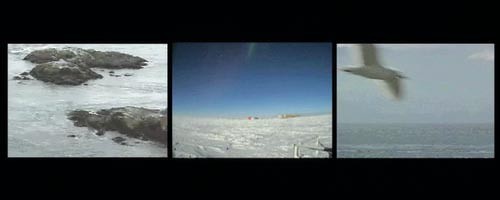You Are Here, an exhibition at SPACE, responds to that most basic question: Where am I? Curator Robert Raczka presents the work of 11 artists using a variety of media to address the complexity of place in the human experience.
Despite that variety, You Are Here is cohesive. The artworks share subtexts. For example, the artists' autobiographies creep into their work, suggesting the influence of personal experience on our idea of place.
Clayton Merrell and Melissa Kuntz evoke landscapes of their respective pasts through paint. Merrell uses abstraction and a palate of tawny reds and deep blues on shaped canvases to summon the spanning desert landscapes of the American West. The paintings of Kuntz (who's also a frequent CP art reviewer) feature not New Jersey's shoreline, but its ubiquitous coastal motels. Rendered with photo-realistic sharpness, the cropped images reveal patterns of beach architecture often overlooked.
Prajna Parasher and Liana Dragoman, meanwhile, deal with the act of remembering a place. Dragoman's floor installation "Lines as Sites -- Repositories of Lost Imaginings" is composed of wood blocks, cardboard, newsprint and flickering light-boxes arranged in a flowing pattern. The organic associations of the materials and design suggest an early memory of place. Parasher's lush, ephemeral ink-jet prints are composed of paintings and collaged film frames that recall her childhood in India.
Another commonality among the works is fragmentation. The technique is used both formally and conceptually. But instead of highlighting incompleteness, You Are Here strives to create cohesion from our fragmentary existence.
Take Carin Mincemoyer's playful series of "model landscapes" and Nayda Collazo-Llorens' thought-provoking installation, "Restructured Topography." Mincemoyer molds her 21 miniature landscapes on empty plastic retail containers. The transparent, tray-like models incorporate natural elements like dirt and sand. Wall-mounted at various heights, these organically tactile landscapes explore our perception of nature as a contained entity.
Collazo-Llorens's site-specific installation, meanwhile, is the highlight of the exhibition. Using scientific data from the Bermuda Triangle, she plots random points and darting, criss-crossing vectors across walls and windows. The lines approach a central vortex in the gallery's rounded-glass corner. Her work beautifully conveys the complexity and patterned randomness of incident.
Curator Raczka's own photographic work, "Meadville, Pennsylvania, March 13, 2007," is a series shot during a walk he took one night, installed horizontally and in chronological order. The disjointed images rely on each other for context, but the arrangement implies a filmstrip narrative.
Michael Sherwin's video projection "Strange Attractors" is a shifting, pulsating triptych that depicts a day in two minutes using videos of natural landscapes appropriated from science Web sites. Striking time-lapse images of the North and South poles anchor the piece, as other images fade in and out. The video's composition suggests the interconnectedness of place despite the fragmentary process used to create the work.
The most literal expression of the show's title is Carlos Rosas' video installation "Location: Pittsburgh, PA, Latitude: 40.45726, Longitude: -79.973499." Rosas's fragmented images of Pittsburgh are intercut with a live feed of the gallery. As in "Strange Attractors," surveillance is a subtext. But Rosas presents it as novelty, acknowledging the inherent excitement of seeing oneself on a TV screen.
Bob Radawec's five acrylic paintings titled "Out of the Blue, the Turn Around" depict the cloud trails of United Flight 93. He captures the fleeting marks of the doomed plane as it turned around over Cleveland, Radawec's hometown. In the gallery, a surveillance camera placed at navel height is angled downward. This juxtaposition suggests the heightened surveillance and loss of privacy since 9/11.
Lastly, Mary Jean Kenton's mixed-media drawings refer to her farm in Fayette County. Kenton incorporates artist statements directly within the compositions. Conceptually, the work fits the exhibition. But the use of WriteNow software to print the text prevents Kenton's words from having the aesthetic weight they deserve.
You Are Here could itself use more informative wall-texts. Nonetheless, the common threads of autobiography, fragmentation and surveillance connect each artwork to the fabric of the exhibition, even as they compete with each other.
You Are Here continues through Aug. 9. SPACE, 812 Liberty Ave., Downtown. 412-325-7723
Editor's note: An earlier version of this review misidentified Mary Jean Kenton's home and some elements of her artwork.















